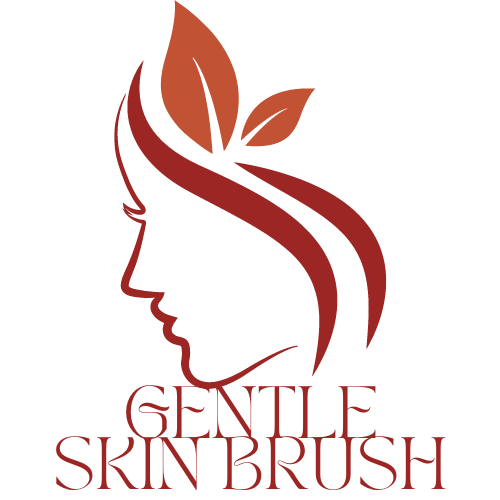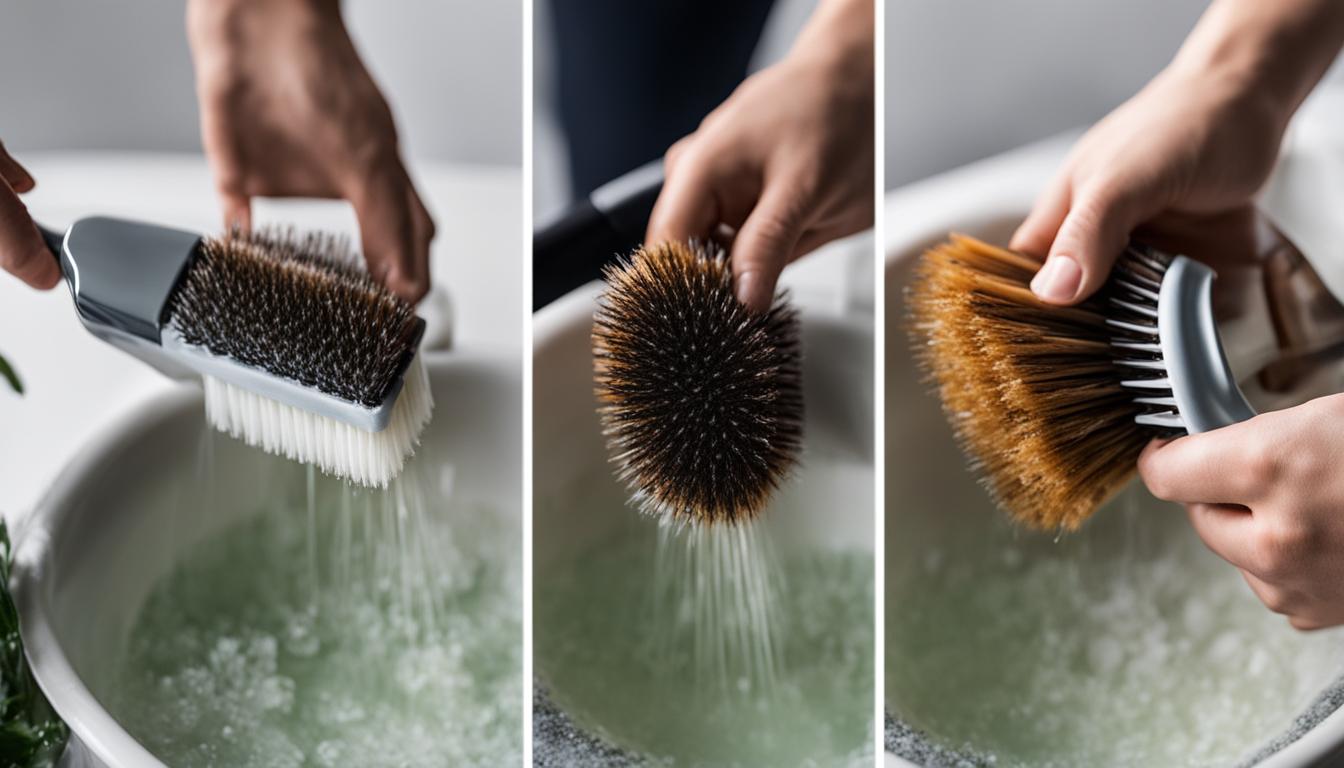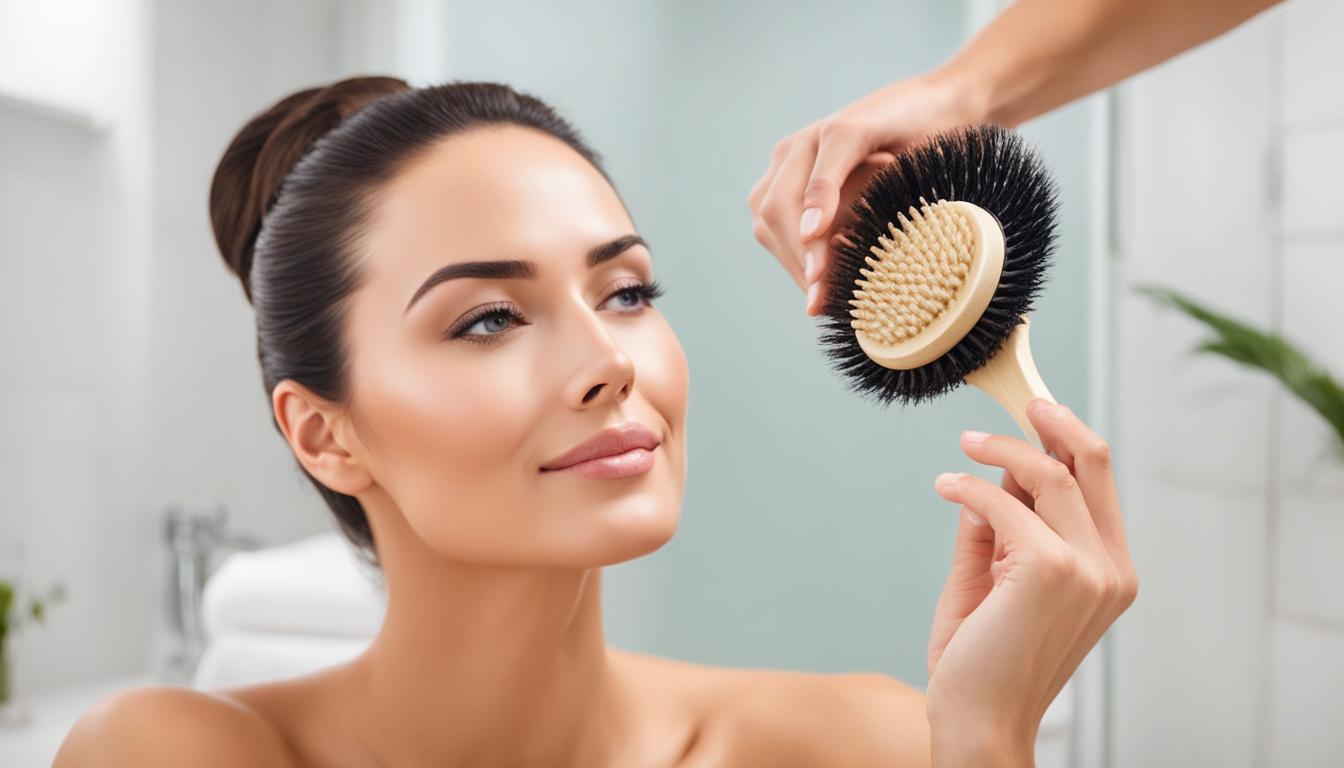Cleaning your hairbrush is an essential part of maintaining healthy and beautiful hair. Over time, hairbrushes can accumulate dirt, oils, and product buildup, which can transfer back onto your hair and scalp. By learning the best methods for cleaning your hairbrush, you can ensure that it remains clean and hygienic.
To effectively clean your hairbrush at home, start by removing any hair and debris that has accumulated in the bristles. You can use your fingers or a comb to gently pull out the hair or cut away any strands wound around a round brush. There are also specialized tools available for this purpose.
Once the hair is removed, it’s time to clean the brush with shampoo and warm water. Add a drop of shampoo to a bowl of warm water and swish the brush around to create a lather. Gently scrub the bristles with your fingers or a toothbrush to remove dirt and product buildup. Rinse the brush thoroughly and make sure to dry it with the bristles facing down to prevent water from getting trapped in the base.
Contents
- 1 How to Clean Different Types of Hairbrushes
- 2 How to Clean your Hairbrushes & Combs
- 3 Why Cleaning Your Hairbrush is Important
- 4 Signs You Need to Replace Your Hairbrush
- 5 Conclusion
- 6 FAQ
- 6.1 What should I soak my hairbrush in to clean it effectively?
- 6.2 How do I clean different types of hairbrushes?
- 6.3 How do I clean my hairbrushes and combs?
- 6.4 Why is cleaning my hairbrush important?
- 6.5 What are the signs that I need to replace my hairbrush?
- 6.6 How often should I clean my hairbrush?
- 7 Source Links
Key Takeaways:
- Regularly clean your hairbrush to remove dirt, oils, and product buildup.
- Remove hair and debris from the bristles before cleaning.
- Wash your hairbrush with a drop of shampoo and warm water.
- Gently scrub the bristles to remove dirt and buildup.
- Dry the brush with the bristles facing down to prevent water from getting trapped.
How to Clean Different Types of Hairbrushes
When it comes to cleaning your hairbrush, different types of brushes require specific techniques to ensure they are thoroughly cleaned. Whether you have synthetic bristle hairbrushes, boar’s bristle hairbrushes, or wooden-handled brushes, here are some tips to keep them clean and in good condition:
Synthetic Bristle Hairbrushes
- Fill a bowl with warm water and add a few drops of shampoo.
- Swirl the brush head in the water to loosen any dirt or buildup.
- Use your fingers or a toothbrush to agitate the bristles and remove any remaining residue.
- Wipe down the handle with a damp cloth.
- Allow the brush to dry with the bristles facing down to prevent water from seeping into the handle.
Boar’s Bristle Hairbrushes
- Fill a shallow bowl with warm water and add a small amount of shampoo.
- Gently work the soapy water between the rows of bristles using your fingers.
- Avoid soaking the handle in water to prevent damage.
- Rinse the brush under running water to remove any soap residue.
- Dry the brush with the bristles facing down to allow any remaining water to drip off.
Cleaning Wooden-handled Brushes
- Use a toothbrush or a small brush with soft bristles to clean the bristles.
- Dip the brush into a mixture of warm water and shampoo, then gently scrub the bristles.
- Wipe the handle with a damp cloth to remove any dirt or residue.
- Avoid soaking the wooden handle in water, as it can cause damage.
- Allow the brush to air dry with the bristles facing down.
Regularly cleaning your hairbrushes is essential to maintain their effectiveness and prevent the buildup of oils, product residue, and bacteria. By following these guidelines, you can keep your hairbrushes clean and in optimal condition for styling your hair.
| Hairbrush Type | Cleaning Technique |
|---|---|
| Synthetic Bristle Hairbrushes | Swirl brush head in warm water with shampoo, agitate bristles, wipe handle, and dry with bristles down. |
| Boar’s Bristle Hairbrushes | Gently work soapy water between bristles, rinse, and dry with bristles facing down. |
| Wooden-handled Brushes | Use a toothbrush or soft-bristled brush to clean bristles, wipe handle, and allow to air dry with bristles down. |
How to Clean your Hairbrushes & Combs
Cleaning your hairbrushes and combs regularly is crucial to maintain their hygiene and ensure optimal hair health. Different types of brushes and combs require specific cleaning techniques to effectively remove dirt, oils, and product buildup. Here’s a step-by-step guide on how to clean your hairbrushes and combs:
Cleaning Synthetic Combs
- Soak the synthetic comb in warm water with a squirt of shampoo for at least 10 minutes to loosen any residue.
- Use a toothbrush to gently scrub away any remaining buildup.
- Rinse the comb thoroughly to remove all traces of shampoo.
Cleaning Wooden Combs
- Wooden combs should not be soaked in water, as it can damage the wood.
- Instead, use a toothbrush dipped in soapy water to clean the teeth of the comb.
- Wipe the handle of the comb with a towel dampened with soapy water.
- For added cleanliness, lightly spray the comb with a disinfecting spray and wipe it dry.
Removing Lint and Dust
To remove lint and dust from the base of the brush, use a clean, dry toothbrush to sweep between the bristles. This will help to keep your brush clean and prevent any buildup that can transfer back to your hair.
Remember to rinse your hairbrushes and combs thoroughly after cleaning and allow them to air dry with the bristles facing down. Maintaining clean hairbrushes and combs not only improves hair health but also ensures that your styling tools remain effective and long-lasting.
| Type of Comb/Brush | Cleaning Method |
|---|---|
| Synthetic Comb | Soak in warm water with shampoo, scrub with toothbrush, and rinse thoroughly. |
| Wooden Comb | Clean teeth with soapy toothbrush, wipe handle, and sanitize with disinfecting spray. |
Why Cleaning Your Hairbrush is Important
Keeping your hairbrush clean is crucial for maintaining the cleanliness and health of your hair. Regular cleaning helps to remove bacteria, oils, and product buildup that can accumulate on the bristles of your brush over time. Failure to clean your hairbrush can lead to scalp infections, dull-looking hair, and even worsen existing scalp conditions like dandruff.
By cleaning your hairbrush regularly, you can prevent these issues and enjoy a cleaner, healthier scalp and hair. Here are some key benefits of cleaning your hairbrush:
- Bacteria prevention: A dirty hairbrush can harbor bacteria and germs, especially if there is hair product residue, oils, or dead skin cells trapped in the bristles. Cleaning your brush removes these impurities, reducing the risk of bacterial growth on your scalp.
- Improved hair health: By removing excess oils and product buildup from your hairbrush, you prevent these substances from transferring back onto your freshly washed hair. This helps to keep your hair cleaner and less prone to greasiness, making it feel lighter and more manageable.
- Enhanced styling results: When your hairbrush is clean, it can glide smoothly through your hair, allowing you to achieve better styling results. Without the hindrance of old hairs and product residue, your brush can evenly distribute natural oils from your scalp, promoting healthier hair growth and a shinier appearance.
Regularly cleaning your hairbrush is a simple and effective way to maintain the hygiene of both your brush and your hair. By incorporating this into your hair care routine, you can enjoy cleaner, healthier, and more beautiful hair every day.
| Hairbrush Cleanliness | Bacteria in Hairbrush | Benefits of Cleaning Hairbrush | Preventing Scalp Infections | |
|---|---|---|---|---|
| Importance | Essential for hair hygiene | Can harbor bacteria and germs | Improved hair health and styling | Reduces risk of infections |
| Methods | Gently remove hair and buildup | Wash with shampoo and warm water | Prevent product transfer to hair | Keep scalp clean and healthy |
| Frequency | Recommended once a month | Regularly to avoid bacterial growth | Regular cleaning for desired results | Preventative measure for scalp infections |
Signs You Need to Replace Your Hairbrush
Knowing when to replace your hairbrush is essential for maintaining the health and effectiveness of your styling tool. Over time, hairbrushes can wear out and become less effective at detangling and styling hair. Here are some signs that indicate it’s time to buy a new hairbrush:
- Worn-out bristles: If you notice that the bristles of your hairbrush are bent, frayed, or missing, it’s a clear sign that the brush is no longer able to effectively detangle your hair. Worn-out bristles can also cause breakage and damage to your hair strands.
- Limited cleaning effectiveness: If you find it increasingly difficult to clean your hairbrush and remove hair, product buildup, and oils from the bristles, it may be a sign that the brush is past its prime. A clean and hygienic hairbrush is crucial for maintaining healthy hair.
“A worn-out hairbrush can lead to tangles and breakage, which can negatively impact the health and appearance of your hair.”
The lifespan of a hairbrush depends on its type and quality. Synthetic brushes made of plastic or rubber typically last around 6-12 months, while natural bristle brushes have a lifespan of about 6 months. If your hairbrush is more than five years old or shows signs of significant wear and tear, it’s time to invest in a new one.
By replacing your hairbrush when necessary, you can ensure that you have a tool that effectively detangles, styles, and maintains the health of your hair. A new hairbrush can make a noticeable difference in the appearance and feel of your hair, giving you a fresh start for better hair care.
| Signs You Need to Replace Your Hairbrush | Solutions |
|---|---|
| Worn-out bristles | Buy a new hairbrush with sturdy bristles to prevent breakage and damage. |
| Limited cleaning effectiveness | Invest in a new hairbrush for improved hygiene and easy maintenance. |
Conclusion
Cleaning and maintaining your hairbrush is an essential part of your hair care routine. By regularly removing hair and buildup from your brush, you can promote hair health and keep it looking its best. Remember to follow the specific cleaning techniques for different types of brushes to ensure effective results.
Good hairbrush hygiene is crucial for preventing bacterial growth and maintaining the cleanliness of your hair. By practicing proper cleaning techniques and regular maintenance, you can avoid scalp infections and keep your hair in optimal condition.
Here are a few tips for maintaining a clean hairbrush:
- Remove hair from your brush regularly to prevent buildup.
- Clean your brush with warm water and shampoo at least once a month to remove dirt and oils.
- Let your brush dry with the bristles facing down to prevent water damage.
- Replace your hairbrush when the bristles become worn out or the brush shows signs of significant wear.
By following these simple tips and incorporating them into your regular hair care routine, you can ensure that your hairbrush remains clean, hygienic, and effective in maintaining the health and appearance of your hair.
FAQ
What should I soak my hairbrush in to clean it effectively?
You can soak your hairbrush in warm water with a drop of shampoo to remove dirt, product buildup, and oils.
How do I clean different types of hairbrushes?
For synthetic bristle hairbrushes, swirl the brush head in warm water with a few drops of shampoo. For wooden-handled brushes, use a toothbrush and soapy water to clean the bristles and wipe the handle. For natural bristle brushes, soak the brush in warm water and shampoo and gently work between the rows of bristles.
How do I clean my hairbrushes and combs?
Synthetic combs can be soaked in warm water with shampoo, scrubbed with a toothbrush, and rinsed well. Wooden combs should be cleaned with a toothbrush and soapy water for the teeth, and can be lightly sprayed with a disinfecting spray. Use a clean, dry toothbrush to sweep lint and dust from the base of the brush.
Why is cleaning my hairbrush important?
Cleaning your hairbrush removes bacteria, oils, and hair product buildup, preventing them from transferring back onto your freshly washed hair. Failure to clean your hairbrush can lead to scalp infections and dull-looking hair.
What are the signs that I need to replace my hairbrush?
Signs to replace your hairbrush include worn-out bristles, bristles falling out, and difficulty in getting the brush clean. Plastic or rubber brushes typically last 6-12 months, while natural bristle brushes last about 6 months.
How often should I clean my hairbrush?
It is recommended to clean your hairbrush about once a month or more often if there is a lot of product buildup or shedding.





Leave a Reply